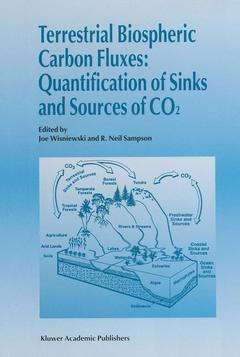Terrestrial Biospheric Carbon Fluxes Quantification of Sinks and Sources of CO2, Softcover reprint of the original 1st ed. 1993
Langue : Anglais
Coordonnateurs : Wisniewski Joe, Sampson R. Neil

Towards the Balance and Management of the Carbon Budget of the Biosphere The current state of misunderstanding of the global C cycle and our failure to resolve an issue that has been debated for 100 years (Jones and Henderson-Sellers, 1990) speaks loudly about the limitations of modem science when faced with the complexity of the biosphere. Efforts to understand and balance the global C budget have gone through several phases. First was a holistic view of the C budget as part of efforts to understand the geochemistry of the Earth (e. g. , Clarke, 1908). Next, came a period of data collection and sythesis which focused on the diversity of sectors of the biosphere. This phase culminated in the early 1970's with the realization that humans were greatly impacting the global C cycle as measured at the Mauna Loa Observatory (Keeling et al. , 1973). New syntheses of the global C budget emerged at this time (Woodwell and Pacan, 1973; Bolin et al. , 1979). The next phase was one of controversy and intense focus on particular sectors of the biosphere. The controversy rested on discrepancies about the role of the terrestrial biota in the global C cycle and the failure to account for sufficient C sinks to absorb all the C emitted by land-use change in the tropics (Woodwell et al. , 1978, 1983; Houghton et al. , 1983).
Workshop Summary Statement.- The Global Terrestrial Carbon Cycle.- Boreal Forests and Tundra.- Contribution of Temperature Forests to the World’s Carbon Budget.- Tropical Forests: Their Past, Present, and Potential Future Role in the Terrestrial Carbon Budget.- Assessment of C Budget for Grasslands and Drylands of the World.- Agricultural Sources and Sinks of Carbon.- Land and Water Interface Zones.- Biomass Management and Energy.- Contribution of Northern Forests to the Global C Cycle: Canada as a Case Study.- Carbon Sequestration in Norway Spruce in South Sweden as Influenced by Air Pollution, Water Availability, and Fertilization.- Impact of Forests on Net National Emissions of Carbon Dioxide in West Europe.- The Potential Aboveground Carbon Storage of North American Forests.- Comparison of Two Methods to Assess the Carbon Budget of Forest Biomes in the Former Soviet Union.- Pools and Fluxes of Biogenic Carbon in the Former Soviet Union.- Forest Management and Carbon Storage: An Analysis of 12 Key Forest Nations.- Effects of Atmospheric CO2 Enrichment on CO2 Exchange Rates of Beech Stands in Small Model Ecoysystems.- Carbon Trends of Productive Temperature Forests of the Coterminous United States.- The Carbon Cycle and Globa Forest Ecosystem.- Forest Responses to CO2 Enrichment and Climate Warming.- Present Role of German Forests and Forestry in the National Carbon Budget and Options to Its Increase.- Potential For Carbon Sequenstration in the Drylands.- Analysis of Agroecosystem Carbon Pools.- Managing Crop Residues for the Retention of Carbon.- CO2-Emissions from Agriculture: Sources and Mitigation Potentials.- The Effect of Trends in Tillage Practices on Erosion and Carbon Content of Soils in the US Corn Belt.- The Impact of Cultivation on Carbon Fluxes in WoodySavannes of Southern Africa.- Potential Impacts of Elevated CO2 and Above- and Belowground Litter Quality of a Tallgrass Prairie.- Diurnal and Seasonal Carbon Dioxide Exchange and Its Components in Temperate Grasslands in the Netherlands — An Outline of the Methodology.- Major Carbon Reservoirs of the Pedosphere; Source - Sink Relations; Potential of D14C and ?13C as Supporting Methodologies.- Riverine Transport of Atmospheric Carbon: Sources, Global Typology and Budget.- Accord Between Ocean Models Predicting Uptake of Anthropogenic CO2.- U.S. Carbon Offset Potential Using Biomass Energy Systems.- Utilising Biomass Crops as an Energy Source: A European Perspective.- Forest Management and Biomass in the U.S.A..- CO2-Mitigation by Agroforestry.- Terrestrial Carbon Management and Electric Utilities.- Forest Sector Carbon Offset Projects: Near-Term Opportunities to Mitigate Greenhouse Gas Emissions.- Manupilating Biotic Carbon Sources and Sinks for Climate Change Mitigation: Can Science Keep Up With Practice?.- The Interaction of Climate and Land Use in Future Terrestrial Carbon Storage and Release.- Quantifying Feedback Processes in the Response of the Terrestrial Carbon Cycle to Global Change: The Modeling Approach of Image-2.- The Potential Response of Global Terrestrial Carbon Storage To A Climate Change.- Modeling the Effects of Climatic and CO2 Changes on Grassland Storage of Soil C.- Vegetation Redistribution: A Possible Biosphere Source of CO2 During Climatic Change.- Structure of a Global and Seasonal Carbon Exchange Model for the Terrestrial Biosphere the Frankfurt Biosphere Model (FBM).- Epilogue.- List of Participants.- Author Index.
Date de parution : 11-2012
Ouvrage de 696 p.
16x24 cm
Thèmes de Terrestrial Biospheric Carbon Fluxes Quantification of... :
Mots-clés :
Savanna; biosphere; ecosystem; water; air pollution and air quality; ecotoxicology
© 2024 LAVOISIER S.A.S.



